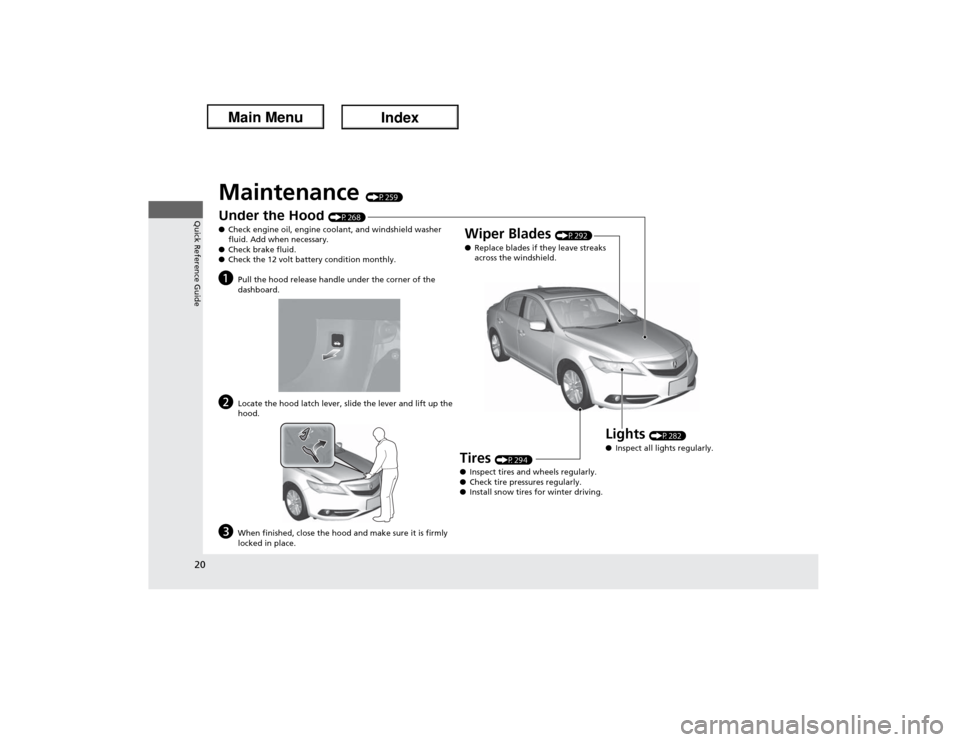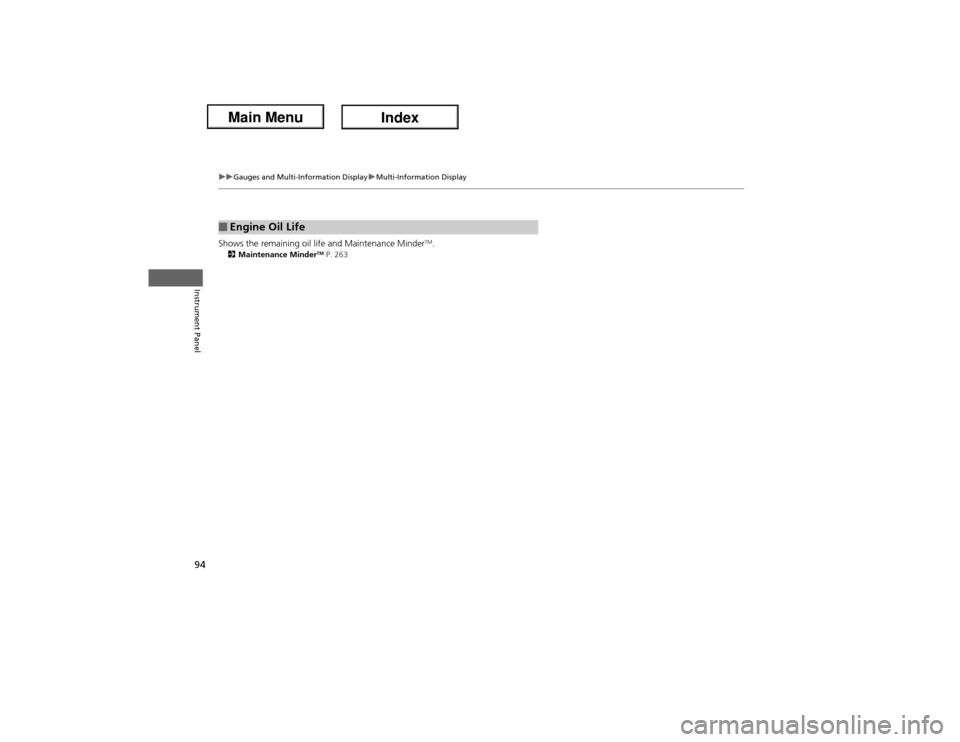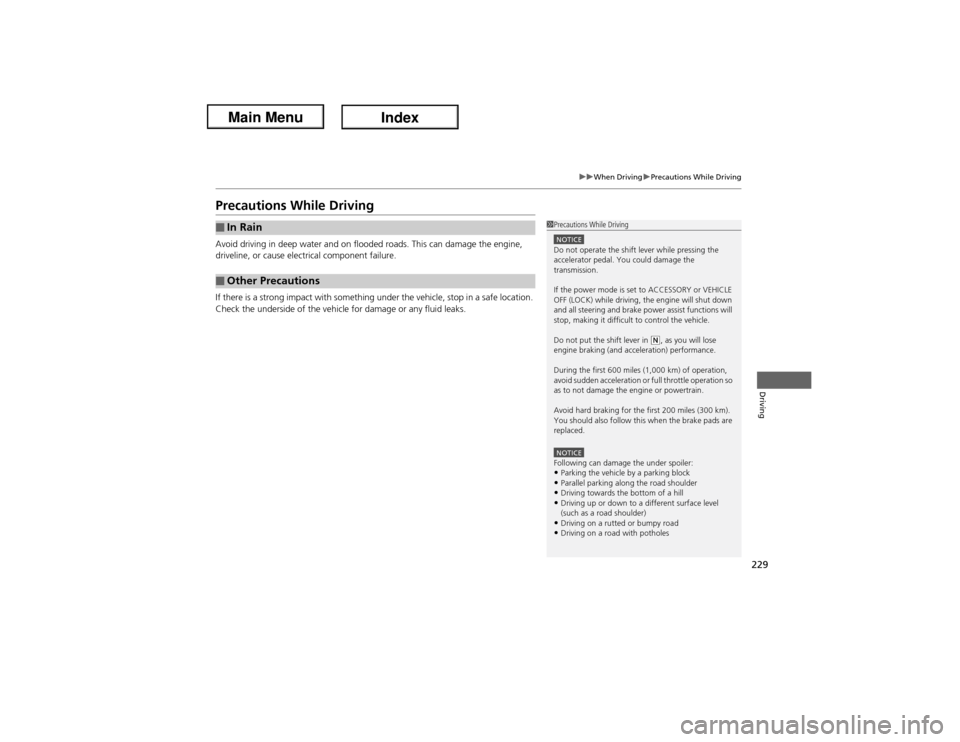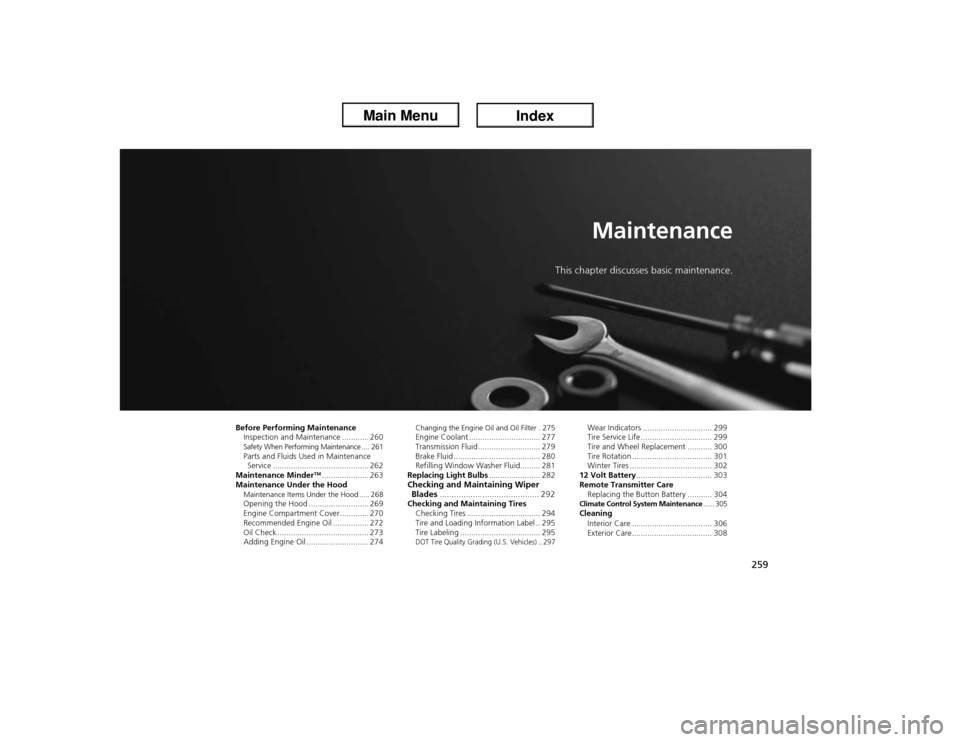oil Acura ILX Hybrid 2013 Owner's Manual
[x] Cancel search | Manufacturer: ACURA, Model Year: 2013, Model line: ILX Hybrid, Model: Acura ILX Hybrid 2013Pages: 365, PDF Size: 8.63 MB
Page 14 of 365

13Quick Reference Guide
Instrument Panel
(P69)
Canada
ECO
N
Gauges
(P86)
/Multi-Information Display
(P87)
/System Indicators
(P70)
System Indicators
Malfunction Indicator
Lamp
Low Oil Pressure
Indicator
Charging System
Indicator
Anti-lock Brake System
(ABS) Indicator
Vehicle Stability Assist
(VSA®) System
Indicator
VSA® OFF IndicatorElectric Power Steering
(EPS) System Indicator
Lights Reminders
Lights On Indicator
High Beam Indicator
Fog Light Indicator Immobilizer System
IndicatorSeat Belt Reminder
Indicator
System Indicators
CRUISE CONTROL
Indicator
System Message
Indicator Parking Brake and
Brake System
Indicator (Red)Supplemental
Restraint System
Indicator
Side Airbag Off
Indicator Door and Trunk Open
Indicator
CRUISE MAIN
Indicator Low Fuel IndicatorLow Tire Pressure/
TPMS Indicator
Turn Signal and
Hazard Warning
Indicators Keyless Access System
Indicator
Charge/Assist Gauge
Security System Alarm Indicator
Fuel Gauge
Tachometer
Multi-Information Display
Speedometer
Shift Lever Position Indicator
Shift Indicator
Low Temperature Indicator
ECON Mode Indicator
Auto Idle Stop Indicator
IMA System Indicator
U.S.
Brake System
Indicator (Amber)
CanadaU.S.
System Indicators
Page 21 of 365

20Quick Reference Guide
Maintenance
(P259)
Under t
he Hoo
d (P268)
●Check engine oil, engine coolant, and windshield washer
fluid. Add when necessary.
●Check brake fluid.
●Check the 12 volt battery condition monthly.
a
Pull the hood release handle under the corner of the
dashboard.
b
Locate the hood latch lever, slide the lever and lift up the
hood.
c
When finished, close the hood and make sure it is firmly
locked in place.
Lights
(P282)
●Inspect all lights regularly.
Wiper Blades
(P292)
●Replace blades if they leave streaks
across the windshield.
Tires
(P294)
●Inspect tires and wheels regularly.
●Check tire pressures regularly.
●Install snow tires for winter driving.
Page 67 of 365

66Safe Driving
Exhaust Gas HazardCarbon Monoxide GasThe engine exhaust from this vehicle contains carbon monoxide, a colorless,
odorless, and highly toxic gas. As long as you properly maintain your vehicle, carbon
monoxide gas will not get into the interior.■Have the exhaust system inspected for leaks whenever
•The exhaust system is making an unusual noise.
•The exhaust system may have been damaged.
•The vehicle is raised for an oil change.
When you operate a vehicle with the trunk open, airflow can pull exhaust gas into
the interior and create a hazardous condition. If you must drive with the trunk open,
open all the windows and set the climate control system as shown below.
1.Select the fresh air mode.
2.Select the mode.
3.Set the fan speed to high.
4.Set the temperature control to a comfortable setting.
Adjust the climate control system in the same manner if you sit in your parked
vehicle with the engine running.
1Carbon Monoxide Gas
An enclosed area such as a garage can quickly fill up
with carbon monoxide gas.
Do not run the engine with the garage door closed.
Even when the garage door is open, drive out of the
garage immediately after starting the engine.
3
WARNING
Carbon monoxide gas is toxic.
Breathing it can cause unconsciousness and
even kill you.
Avoid any enclosed areas or activities that
expose you to carbon monoxide.
Page 76 of 365

75
uuIndicatorsu
Continued
Instrument Panel
Indicator
Name
On/Blinking
Explanation
Message
Low Oil Pressure
Indicator
●Comes on when you set the power
mode to ON, and goes off when the
engine starts.●Comes on when the engine oil
pressure is low.
●Comes on while driving - Immediately
stop in a safe place.
2If the Low Oil Pressure Indicator
Comes On P. 336
Door and Trunk
Open Indicator
●Comes on for a few seconds if you
set the power mode to ON, then
goes off.●Comes on if any door or the trunk is
not completely closed.
●Goes off when all doors and the trunk are
closed.
EPS (Electric
Power Steering)
System Indicator
●Comes on when you set the power
mode to ON, and goes off when the
engine starts.●Comes on if there is a problem with
the EPS (Electric Power Steering)
System.
●Stays on constantly or does not come
on at all - Have the vehicle checked by a
dealer.
2If the EPS System Indicator Comes On
P. 338
Auto Idle Stop
Indicator
●Blinks when Auto Idle Stop is in
operation. The engine automatically
shuts off.
2Auto Idle Stop P. 250
—
Page 89 of 365

88
uuGauges and Multi-Information DisplayuMulti-Information Display
Instrument Panel
OFF
Customize SettingsAverage Fuel Economy/
Instant Fuel Economy
SEL/RESET
Button
Engine Oil Life Average Speed AElapsed Time ARange
Button
Power Flow Monitor Average Fuel
Economy Records Fuel Economy
Indicator
Page 95 of 365

94
uuGauges and Multi-Information DisplayuMulti-Information Display
Instrument Panel
Shows the remaining oil life and Maintenance Minder
TM.
2Maintenance Minder
TM P. 263
■Engine Oil Life
Page 230 of 365

229
uuWhen DrivinguPrecautions While Driving
Driving
Precautions While DrivingAvoid driving in deep water and on flooded roads. This can damage the engine,
driveline, or cause electrical component failure.
If there is a strong impact with something under the vehicle, stop in a safe location.
Check the underside of the vehicle for damage or any fluid leaks.■In Rain■Other Precautions
1Precautions While DrivingNOTICEDo not operate the shift lever while pressing the
accelerator pedal. You could damage the
transmission.
If the power mode is set to ACCESSORY or VEHICLE
OFF (LOCK) while driving, the engine will shut down
and all steering and brake power assist functions will
stop, making it difficult to control the vehicle.
Do not put the shift lever in
(N, as you will lose
engine braking (and acceleration) performance.
During the first 600 miles (1,000 km) of operation,
avoid sudden acceleration or full throttle operation so
as to not damage the engine or powertrain.
Avoid hard braking for the first 200 miles (300 km).
You should also follow this when the brake pads are
replaced.
NOTICEFollowing can damage the under spoiler:•Parking the vehicle by a parking block•Parallel parking along the road shoulder•Driving towards the bottom of a hill•Driving up or down to a different surface level
(such as a road shoulder)•Driving on a rutted or bumpy road•Driving on a road with potholes
Page 250 of 365

249Driving
Parking Your VehicleWhen Stopped1.Depress the brake pedal firmly with the shift lever in
(D.
2.Firmly apply the parking brake.
3.Move the shift lever from
(D to
(P.
4.Turn off the engine.
Always set the parking brake firmly, in particular if you are parked on an incline.
1Parking Your Vehicle
Do not park your vehicle near flammable objects,
such as dry grass, oil, or timber.
Heat from the exhaust can cause a fire.1When StoppedNOTICEThe following can damage the transmission:•Depressing the accelerator and brake pedals
simultaneously.•Holding the vehicle in place when facing uphill by
depressing the accelerator pedal.•Moving the shift lever into
(P before the vehicle
stops completely.
Raise the wiper arms when snow is expected.
Page 257 of 365

256Driving
Fuel EconomyImproving Fuel EconomyFuel economy depends on several conditions, including driving conditions, your
driving habits, the condition of your vehicle, and loading. Depending on these and
other conditions, you may or may not achieve the rated fuel economy of this vehicle.
You can optimize your fuel economy with proper maintenance of your vehicle.
Always maintain your vehicle in accordance with the messages displayed on the
multi-information display.
•Use the recommended viscosity engine oil, displaying the API Certification Seal.
•Maintain the specified tire pressure.
•Do not load the vehicle with excess cargo.
•Keep your vehicle clean. A buildup of snow or mud on your vehicle's underside
adds weight and increases wind resistance.■Maintenance and Fuel Economy
1Improving Fuel Economy
Direct calculation is the recommended method to
determine actual fuel consumed while driving.
In Canada, posted fuel economy numbers are
established following a simulated test. For more
information on how this test is performed, please visit
http://oee.nrcan.gc.ca/
Miles drivenGallons of
fuelMiles per
Gallon
100L per 100 km Kilometers
driven Liters of
fuel
Page 260 of 365

259
Maintenance
This chapter discusses basic maintenance.
Before Performing Maintenance
Inspection and Maintenance ............ 260Safety When Performing Maintenance .... 261Parts and Fluids Used in Maintenance
Service ........................................... 262
Maintenance Minder
TM..................... 263
Maintenance Under the Hood
Maintenance Items Under the Hood ..... 268Opening the Hood ........................... 269
Engine Compartment Cover ............. 270
Recommended Engine Oil ................ 272
Oil Check ......................................... 273
Adding Engine Oil ............................ 274
Changing the Engine Oil and Oil Filter . 275Engine Coolant ................................ 277
Transmission Fluid ............................ 279
Brake Fluid ....................................... 280
Refilling Window Washer Fluid......... 281
Replacing Light Bulbs....................... 282Checking and Maintaining Wiper
Blades.......................................... 292Checking and Maintaining Tires
Checking Tires ................................. 294
Tire and Loading Information Label .. 295
Tire Labeling .................................... 295DOT Tire Quality Grading (U.S. Vehicles) .. 297
Wear Indicators ............................... 299
Tire Service Life ................................ 299
Tire and Wheel Replacement ........... 300
Tire Rotation .................................... 301
Winter Tires ..................................... 302
12 Volt Battery.................................. 303
Remote Transmitter Care
Replacing the Button Battery ........... 304Climate Control System Maintenance...... 305Cleaning
Interior Care .................................... 306
Exterior Care.................................... 308